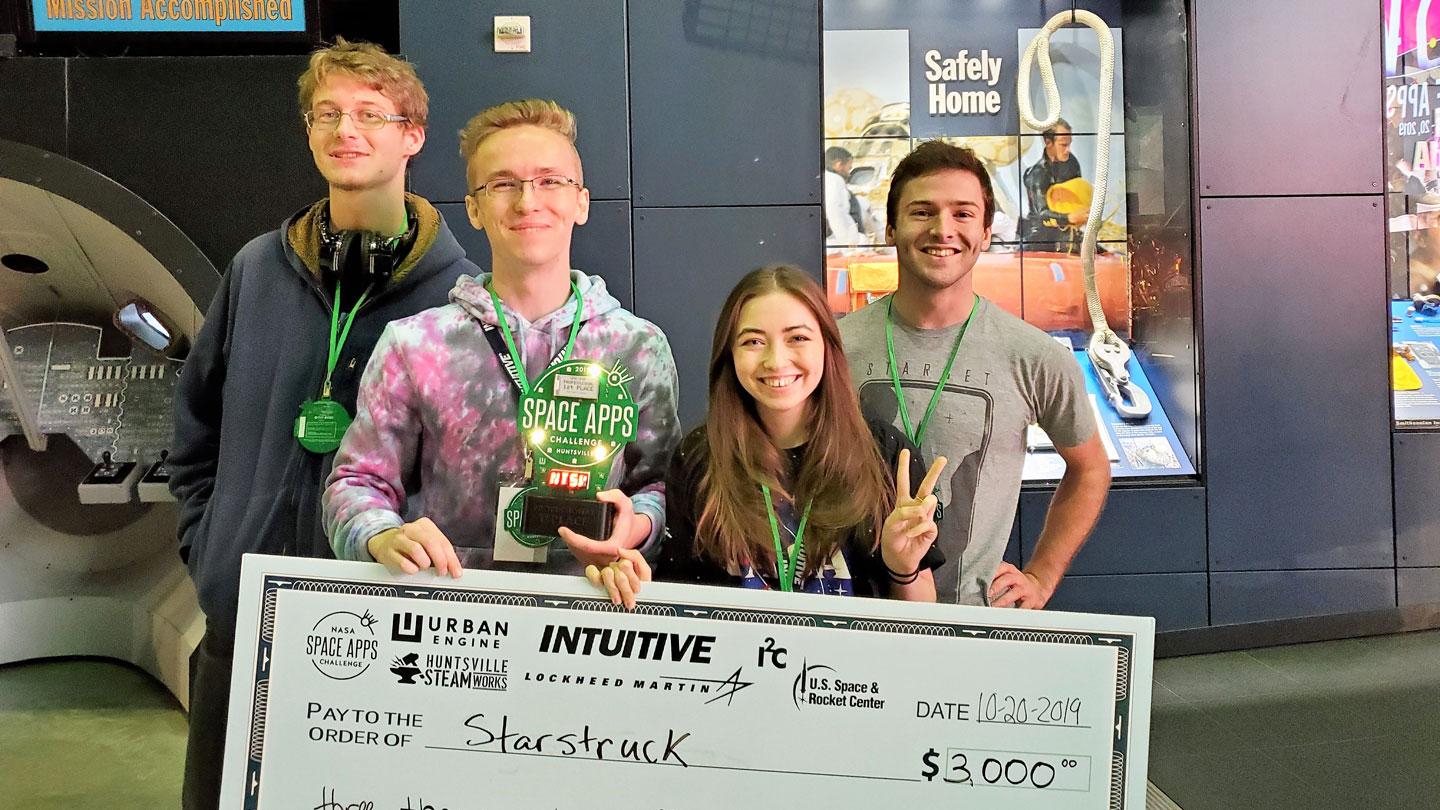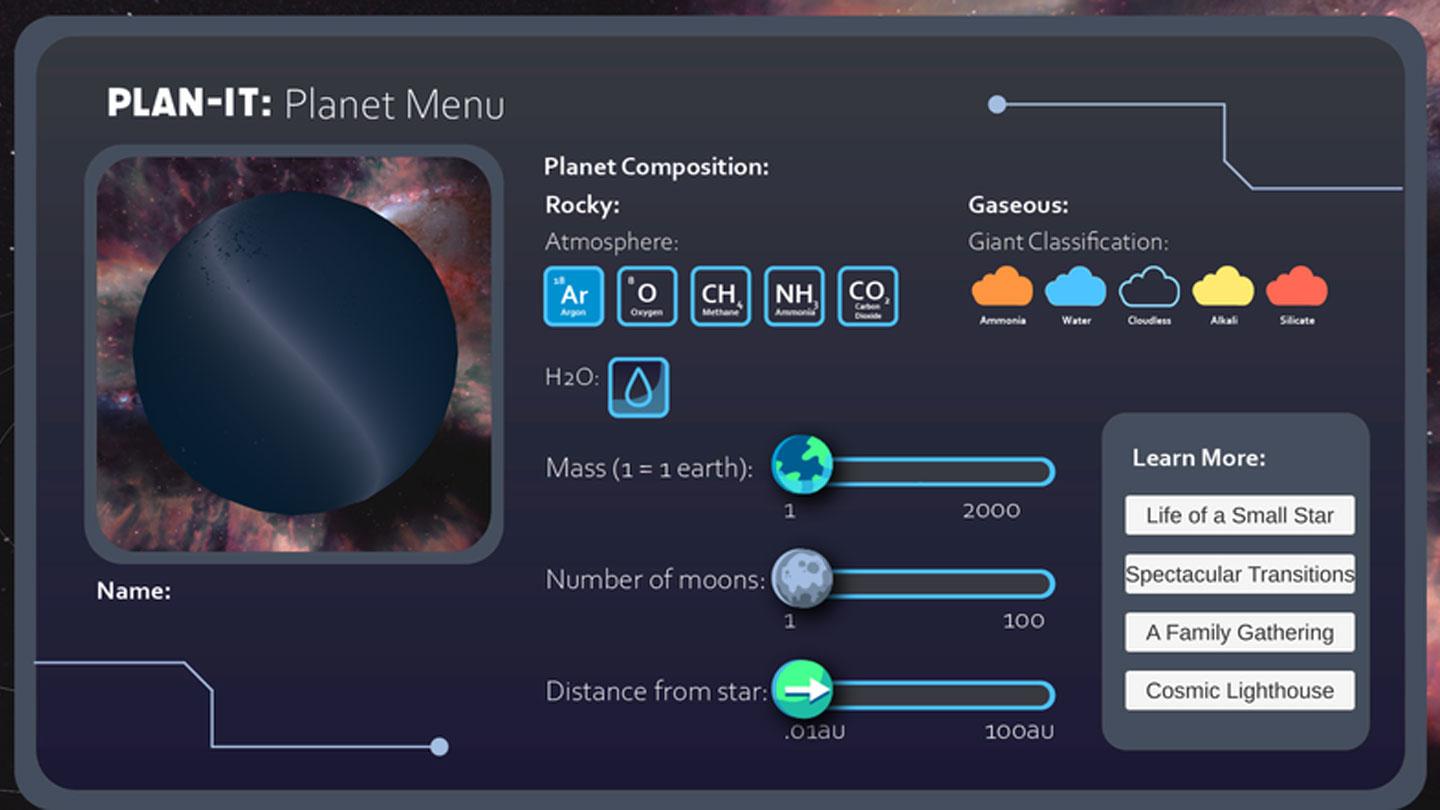KBR Intern Helps Build ‘Plan-It’ Solar System Video Game, Wins NASA’s 2019 Space Apps Challenge
Cory Haralson, KBR’s Government Solutions U.S. Engineering Business Unit intern on the Modeling and Simulation Tools and Software Project, is a member of team StarStruck – global winner of the 2019 NASA International Space Apps Challenge. NASA selected the team as a local grand prize winner out of more than 29,000 participating coders, scientists, designers, storytellers, makers, builders and technologists.
Now in its ninth year, the NASA-led initiative hosts more than 230 events in 80 countries using their free and open data to address real-world problems. In October, the StarStruck team competed in NASA’s local Build-A-Planet challenge, a 48-hour global hackathon held at the University of Alabama’s Huntsville Invention to Innovation Center.
The 2019 challenge tasked students to create a game allowing players to customize the characteristics of a star and design planets that could reasonably exist within that star system. It also needed to serve as an educational experience. In response to the contest, the StarStruck team – four college friends studying computer science with backgrounds in art, game development, and astrophysics – developed a solar system simulation video game called “Plan-It.”
“We had the lofty goal of showing the fundamentals of planets, both rocky terrestrials and gaseous Jovian planets, but also some of the fascinating fringe cases that could possibly exist and the bizarre phenomena that happen all the time,” Haralson said.
“To achieve this, our team decided we needed to make it visually stimulating, as a dull program wouldn’t hold the attention of people, and space is marvelous to look at, so the program should be, too,” he said.
At face-value, Plan-It is a planet generator allowing players to create a new solar system. Informative pop-ups explain to players how their choices change the planets' properties, helping to educate users on various astrophysical concepts. The StarStruck team used Unity, a computer development platform, and C#, a programming language, to create the generator, as well as Adobe Illustrator to create the various artwork within the game.
“I was the astronomy expert of the group,” Haralson said. Before switching to a computer science major, Haralson studied astrophysics. “I spent my time in NASA’s Space Apps website researching different chemical makeups of planets, finding the weird planets that have been hypothesized about, and checking the math behind the simulation.”
After winning locally, StarStruck then went on to compete at the international level and was selected as a global winner in the “Most Inspirational” category. StarStruck is the only U.S.-based team to be selected as a global winner and will now have the opportunity to travel to a NASA site in the Eastern U.S. to present their project to NASA and the Space Apps Global Organizing Team.
For Haralson, both the challenge and interning at KBR have been extremely valuable, noting specifically that his KBR advisors have been very supportive of his interests. “This experience allowed me to branch out to very intelligent people who have helped me in a variety of ways to grow and learn. At KBR, I mostly use C# for my projects, so Space Apps gave me a huge boost into understanding the language.”
Haralson’s manager Chad Stevens said, “Cory brings a level of enthusiasm and positive energy that is contagious, and you can see that in his work. We are proud to have him as part of our team, and proud of his achievement as a winner of the NASA Space Apps Challenge.”
Haralson hopes projects like Plan-It will help to spark the wonder that exists in everyone. “Maybe it will put someone on the path to space exploration, or be a fun thing someone can share with their friends and family. There is so much about the universe that breeds art and wonder through science that we don’t know about,” he said.
Plan-It is more than just a game. It’s about aiding humanity in its mission to detect new exoplanets and better understand their characteristics and habitability.
“The future of space exploration seems so open to me. I’ve read about experimental propulsion systems, understanding and overcoming health issues with long term space travel, goals to go closer to the sun than ever before, even how origami can help future light sails,” Haralson said. “There is no limit to how people are imagining solutions to problems that we haven’t considered before.”
Learn more about StarStruck and the NASA Space Apps Challenges here: spaceappschallenge.org.





